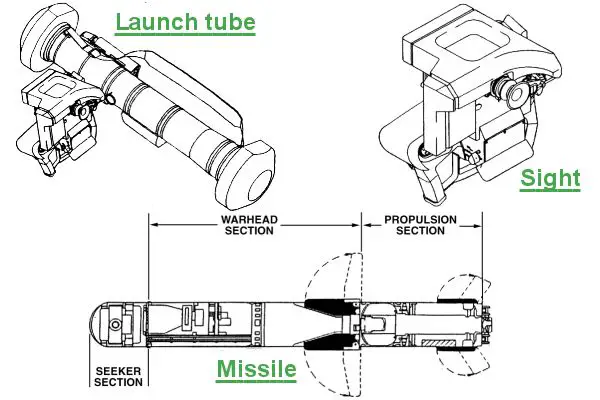Lockheed Martin is responsible for the missile seeker, engineering and assembly. The Javelin has been combat proven in Afghanistan and Iraq by U.S. and allied soldiers, Marines and Special Forces. Eleven countries have selected Javelin to meet anti-armor requirements. This missile also has the ability toengage helicopters in the direct attack mode. It can reach a peak altitude of 150 m (500 ft) in top-attack mode and 60 m in direct-fire mode. It is equipped with an imaging infrared seeker , which is based on a cadmium mercury telluride (CdHgTe) 64 x 64 staring focal plane array in the 8 micron to 12 micron waveband. BAE Systems Avionics is providing the infrared seekers for the British army's missiles. The tandem warhead is fitted with two shaped charges: a precursor warhead to detonate any explosive reactive armor and a primary warhead to penetrate base armor. The propulsion system is a two-stage solid propellant design, which provides a minimum smoke soft launch. Its direct-attack capability will engage targets with overhead cover or in bunkers. Its "soft launch" allows employment from within buildings and enclosed fighting positions. The soft launch signature limits the gunner's exposure to the enemy, thus increasing survivability.
The Block 1 missile upgrade includes an improved rocket motor that reduces time of flight, an enhanced warhead effective against a greater range of targets, 2,500m of improved probability of hit / kills and improvements to the command launch unit and software. In 2008, the improved Block 1 missile full material release was received and the US army has stockpiled the first production lots.
Other improvements include a digital display, software processing enhancement and remote view of the gunner display in an RS-170 standard video format. The future Javelin will have fragmentation for anti-personnel effects and a multipurpose warhead (MPWH) with shaped charges for armoured vehicles.
The missile system is most often carried by a two-man team consisting of a gunner and an ammo bearer, although it can be fired with just one person if necessary. While the gunner aims and fires the missile, the ammo bearer scans for prospective targets, watches for threats, such as enemy vehicles and troops, and ensures that personnel and obstacles are clear of the missile's back blast.
The system is deployed and ready to fire in less than 30s and the reload time is less than 20s. The missile is mounted on the CLU (Command Launch Unit) and the gunner engages the target using the sight on the CLU, by placing a curser box over the image of the target. The gunner locks on the automatic target tracker in the missile by sending a lock-on-before-launch command to the missile. When the system is locked-on, the missile is ready to fire and the gunner does not carry out post launch tracking or missile guidance.
Unlike laser beam riding or conventional wire or fibre-optic cable guided missiles, Javelin is autonomously guided to the target after launch, leaving the gunner free to reposition or reload immediately after launch.
A soft launch ejects the missile from the launch tube to give a low-recoil shoulder launch. The soft launch enables firing from inside buildings or covered positions. Once the missile is clear, the larger propellant in the second stage is ignited and the missile is propelled towards the target. The weapon has two attack modes, direct or top attack.
The gunner selects direct attack mode to engage covered targets, bunkers, buildings and helicopters.
The top attack mode is selected against tanks, in which case the Javelin climbs above and strikes down on the target to penetrate the roof of the tank where there is the least armour protection.
The missile is launched at an 18° elevation angle to reach a peak altitude of 150m in top attack mode and 50m in direct fire mode.
Specifications
Weight :
22.3 kg (49.2 lb) (carry weight)
Weight Detachable CLU:
6.4 kg (14.1 lb)
Length Missile :
1.1 m (43 in)
Length Launch tube :
1.2 m (47 in)
Diameter Missile :
127 mm (5.0 in)
Diameter Launch tube :
142 mm (5.6 in)
Crew :
2
Effective firing range :
75 to 2,500 m
Maximum firing range :
4,750 m (tested)
Warhead :
Tandem shaped charge HEAT
Warhead weight :
8.4 kg (18.5 lb)
Detonation mechanism :
Impact force
Engine :
Solid fuel rocket
Guidance system :
Passive target acquisition/ fire control with integrated day/thermal sight
Accessories :
Imaging infra-red and Magnification 4x day and 4x or 9x thermal


No comments:
Post a Comment